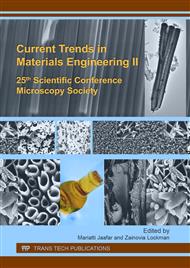[1]
H.M. Akil, M.F. Omar, A.A.M. Mazuki, S. Safiee, Z.A.M. Ishak, A.A. Bakar, Kenaf fiber reinforced composites: A review, Mater. Des. 32 (2011) 4107-4121.
DOI: 10.1016/j.matdes.2011.04.008
Google Scholar
[2]
A.L. Pang, and H. Ismail, Studies on the properties of polypropylene/(waste tire dust)/kenaf (PP/WTD/KNF) composites with addition of phthalic anhydride (PA) as a function of KNF loading, J. Vinyl. Add. Tecnhol. 20 (2014) 193-200.
DOI: 10.1002/vnl.21365
Google Scholar
[3]
M. George, P.G. Mussone, D.C. Bressler, Modification of the cellulosic component of hemp fibers using sulfonic acid derivatives: Surface and thermal characterization, Carbohyd. Polym. 134 (2015) 230-239.
DOI: 10.1016/j.carbpol.2015.07.096
Google Scholar
[4]
R. Malkapuram, V. Kumar, Y. S. Negi, Recent development in natural fiber reinforced polypropylene composites, J. Reinf. Plast. Compos. 28 (2009) 1169-1189.
DOI: 10.1177/0731684407087759
Google Scholar
[5]
A.L. Pang, H. Ismail, A.A. Bakar, Effects of kenaf loading on processability and properties of linear low-density polyethylene/poly (vinyl alcohol)/kenaf composites, Biores. 10 (2015) 7302-7314.
DOI: 10.15376/biores.10.4.7302-7314
Google Scholar
[6]
N.S. Balakrishna, H. Ismail, N. Othman, The effects of rattan filler loadings on properties of rattan powder-filled polypropylene composites, Biores. 7 (2012) 5677-5690.
DOI: 10.4028/www.scientific.net/amr.626.1010
Google Scholar
[7]
M. Farsi, Thermoplastic matrix reinforced with natural fibers: A study on interfacial behavior, in: J. Wang (Ed. ), Some critical issues for injection molding, In Tech Publisher, Croatia, 2012, pp.225-250.
DOI: 10.5772/34527
Google Scholar
[8]
N.F. Zaaba, H. Ismail, M. Jaafar, The effects of modifying peanut shell powder with polyvinyl alcohol on the properties of recycled polypropylene and peanut shell powder composites, Biores. 9 (2014) 2128-2142.
DOI: 10.15376/biores.9.2.2128-2142
Google Scholar
[9]
M.M. Kabir, H. Wang, K.T. Lau, F. Cardona, Chemical treatments on plant-based natural fiber reinforced polymer composites: An overview, Compos. Part B, 43 (2012) 2883-2892.
DOI: 10.1016/j.compositesb.2012.04.053
Google Scholar
[10]
A.L. Pang, H. Ismail, A.A. Bakar, Tensile properties, water resistance, and thermal properties of linear low-density polyethylene/polyvinyl alcohol/kenaf composites: Effect of 3-(trimethoxysilyl)propyl methacrylate (TMS) as a silane coupling agent, Biores. 11 (2016).
DOI: 10.15376/biores.11.3.5889-5904
Google Scholar
[11]
B.K. Tan, Y.C. Ching, S.N. Gan, S. Ramesh, M.R. Rahman, Water absorption properties of kenaf fibre-poly (vinyl alcohol) composites, Mater. Research. Inno. 18 (2014) 144-146.
DOI: 10.1179/1432891714z.000000000946
Google Scholar


